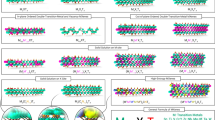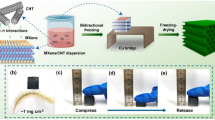Abstract
In this study, we demonstrate that by directly employing single-walled carbon nanotube arrays (SWCNT-arrays)—grown on conductive substrates—as working electrodes, selective and uniform electrodeposition of a conducting polymer, namely poly(3-hexylthiophene), can be achieved on the surface of the nanotubes. The overall kinetic pattern of the electrodeposition was studied by separating the deposition charge from the one related to the redox transformation of the polymer film deposited during the precedent cycles. Both the structure and the electrochemical properties of the hybrid materials were studied as a function of the electrodeposition cycles, thus the amount of the formed polymer. The hybrids were characterized by electron microscopic (SEM, TEM) and vibrational spectroscopic (Raman spectroscopy) means. The obtained results were compared and contrasted with those gathered on macroscopic-sized multi-walled carbon nanotube array-based composites in our group recently. Overall, we conclude that electrochemical polymerization is an attractive tool to synthesize conducting polymer/SWCNT hybrid materials with controlled composition and morphology.

Highy organized nanostructures of conduction polymer/SWCNT array hybrids were obtained via electrodeposition










Similar content being viewed by others
References
Bergmann CP, de Andrade MJ (2011) Nanostructured materials for engineering applications. Springer, Berlin
Kumar SK, Krishnamoorti R (2010) Nanocomposites: structure, phase behavior, and properties. Annu Rev Chem Biomol Eng 1:37–58
Schadler LS, Kumar SK, Benicewicz BC et al (2007) Designed interfaces in polymer nanocomposites: a fundamental viewpoint. MRS Bull 32:335–340
Gangopadhyay R, De A (2000) Conducting polymer nanocomposites: a brief overview. Chem Mater 12:608–622
Bai S, Shen X (2012) Graphene–inorganic nanocomposites. RSC Adv 2:64–98
Srivastava S, Kotov NA (2008) Composite layer-by-layer (LBL) assembly with inorganic nanoparticles and nanowires. Acc Chem Res 41:1831–1841
Kango S, Kalia S, Celli A et al (2013) Surface modification of inorganic nanoparticles for development of organic- inorganic nanocomposites—a review. Prog Polym Sci 38:1232–1261
Rajamathi M, Seshadri R (2002) Oxide and chalcogenide nanoparticles from hydrothermal/solvothermal reactions. Curr Opin Solid State Mater Sci 6:337–345
Lakshmi BB, Patrissi CJ, Martin CR (1997) Sol-gel template synthesis of semiconductor oxide micro- and nanostructures. Chem Mater 9:2544–2550
Kruis FE, Fissan H, Peled A (1998) Synthesis of nanoparticles in the gas phase for electronic, optical and magnetic applications—a review. J Aerosol Sci 29:511–535
Janáky C, Rajeshwar K (2015) The role of (photo)electrochemistry in the rational design of hybrid conducting polymer/semiconductor assemblies: from fundamental concepts to practical applications. Prog Polym Sci 43:96–135
Mohanty US (2011) Electrodeposition : a versatile and inexpensive tool for the synthesis of nanoparticles, nanorods, nanowires, and nanoclusters of metals. J Appl Electrochem 41:257–270
Georgakilas V, Gournis D, Tzitzios V et al (2007) Decorating carbon nanotubes with metal or semiconductor nanoparticles. J Mater Chem 17:2679–2694
Huang X, Qi X, Boey F, Zhang H (2012) Graphene-based composites. Chem Soc Rev 41:666–686
Zhang Q, Huang J-Q, Qian W-Z et al (2013) The road for nanomaterials industry: a review of carbon nanotube production, post-treatment, and bulk applications for composites and energy storage. Small 9:1237–1265
Frackowiak E (2001) Carbon materials for the electrochemical storage of energy in capacitors. Carbon N Y 39:937–950
Kecsenovity E, Endrődi B, Pápa Z et al (2016) Decoration of ultra-long carbon nanotubes with Cu2O nanocrystals: a hybrid platform for enhanced photoelectrochemical CO2 reduction. J Mater Chem A 4:3139–3147
Woan BK, Pyrgiotakis G, Sigmund W (2009) Photocatalytic carbon-nanotube—TiO2 composites. Adv Mater 21:2233–2239
Lee K, Zhang J, Wang H, Wilkinson DP (2006) Progress in the synthesis of carbon nanotube- and nanofiber-supported Pt electrocatalysts for PEM fuel cell catalysis. Rev Appl Electrochem 36:507–522
Byrne MT, Gun’ko YK (2010) Recent advances in research on carbon nanotube-polymer composites. Adv Mater 22:1672–1688
Spitalsky Z, Tasis D, Papagelis K, Galiotis C (2010) Carbon nanotube–polymer composites: chemistry, processing, mechanical and electrical properties. Prog Polym Sci 35:357–401
Peng C, Zhang S, Jewell D, Chen GZ (2008) Carbon nanotube and conducting polymer composites for supercapacitors. Prog Nat Sci 18:777–788
Qu F, Yang M, Jiang J et al (2005) Amperometric biosensor for choline based on layer-by-layer assembled functionalized carbon nanotube and polyaniline multilayer film. Anal Biochem 344:108–114
Janáky C, Visy C (2013) Conducting polymer-based hybrid assemblies for electrochemical sensing: a materials science perspective. Anal Bioanal Chem 405:3489–3511
Gao M, Huang S, Dai L et al (2000) Aligned coaxial nanowires of carbon nanotubes sheathed with conducting polymers. Angew Chemie Int Ed 39:3664–3667
Ates M, Karazehir T (2012) Micro-capacitor behavior of poly(3-hexyl thiophene)/carbon fiber/electrolyte system and equivalent circuit model. Polym Plast Technol Eng 51:1258–1265
Rajeshwar K, Janaky C, Kecsenovity E (2016) Electrodeposition of inorganic oxide/nanocarbon composites: opportunities and challenges. ChemElectroChem 3:181–192
Endrődi B, Samu GF, Fejes D et al (2015) Challenges and rewards of the electrosynthesis of macroscopic aligned carbon nanotube array/conducting polymer hybrid assemblies. J Polym Sci Part B Polym Phys 53:1507–1518
Azam MA, Isomura K, Fujiwara A, Shimoda T (2012) Direct growth of vertically aligned single-walled carbon nanotubes on conducting substrate and its electrochemical performance in ionic liquids. Phys Status Solidi 209:2260–2266
Ratcliff EL, Jenkins JL, Nebesny K, Armstrong NR (2008) Electrodeposited, “textured” poly(3-hexyl-thiophene) (e-P3HT) films for photovoltaic applications. Chem Mater 20:5796–5806
Roncali J (1992) Conjugated poly(thiophenes): synthesis, functionalization, and applications. Chem Rev 92:711–738
Chen JH, Li WZ, Wang DZ et al (2002) Electrochemical characterization of carbon nanotubes as electrode in electrochemical double-layer capacitors. Carbon N Y 40:1193–1197
Pieta P, Obraztsov I, Francis D et al (2013) Composites of conducting polymers and various carbon nanostructures for electrochemical supercapacitors. ECS J Solid State Sci Technol 2:M3120–M3134
Star A, Han T-R, Gabriel J-CP et al (2003) Interaction of aromatic compounds with carbon nanotubes: correlation to the Hammett parameter of the substituent and measured carbon nanotube FET response. Nano Lett 3:1421–1423
Huang J, Yang C, Hsu C et al (2009) Solvent-annealing-induced self-organization of poly(3-hexylthiophene), a high-performance electrochromic material. ACS Appl Mater Interfaces 1:2821–2828
Dresselhaus MSS, Dresselhaus G, Saito R, Jorio A (2005) Raman spectroscopy of carbon nanotubes. Phys Rep 409:47–99
Baibarac M, Lapkowski M, Pron A et al (1998) SERS spectra of poly(3-hexylthiophene) in oxidized and unoxidized states. J Raman Spectrosc 29:825–832
Endrődi B, Mellár J, Gingl Z et al (2014) Reasons behind the improved thermoelectric properties of poly(3-hexylthiophene) nanofiber networks. RSC Adv 4:55328–55333
Endrődi B, Mellár J, Gingl Z et al (2015) Molecular and supramolecular parameters dictating the thermoelectric performance of conducting polymers: a case study using poly(3-alkylthiophene)s. J Phys Chem C 119:8472–8479
Acknowledgments
Part of this work was supported by Grant-in-Aid for Japan Society of Promotion Science (JSPS) Research Fellows. MA. Azam is also grateful to the Ministry of Science, Technology and Innovation (MOSTI), Malaysia, for financial support under the eScienceFund research grant scheme.
Author information
Authors and Affiliations
Corresponding authors
Rights and permissions
About this article
Cite this article
Endrődi, B., Samu, G.F., Azam, M.A. et al. Electrochemical synthesis and characterization of poly(3-hexylthiophene)/single-walled carbon nanotube array hybrid materials. J Solid State Electrochem 20, 3179–3187 (2016). https://doi.org/10.1007/s10008-016-3290-8
Received:
Revised:
Accepted:
Published:
Issue Date:
DOI: https://doi.org/10.1007/s10008-016-3290-8




